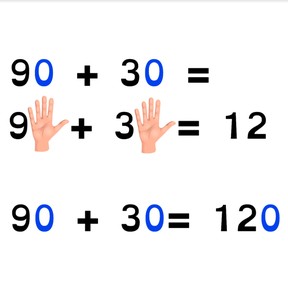



8,000 schools use Gynzy
92,000 teachers use Gynzy
1,600,000 students use Gynzy
General
Students learn to add with tens to 100 using the zero rule. They learn to solve the problem without zeros and then to use that total to help solve the actual addition problem.
Common core standard(s)
2.NBT.B.5
Relevance
If students learn to add to 100 with the zero rule, they learn to add tens faster.
Introduction
Refresh addition problems to 10 by playing a ball game. The teacher says an addition problem (like 3+4) and tosses the ball to a student. They must say the total of the given addition problem. The student tosses the ball back to the teacher and this is repeated a few times.
Development
Discuss that it is important to learn how to work with the zero rule because it helps you add easier and quicker. Remind students that tens are a group of ten and that they end in a 0. Ask students if they can name tens numbers. Then show the zero rule with the addition problems of 1+1 and 10+10 with the fingers and fists as well as MAB blocks to serve as visual support. This allows students to visualize the addition problem without zeros as well as with the zeros.
Next explain the zero rule with an example. Show students that you can remove the zeros when your addition problem is with tens, making the problem ten times smaller and easier to solve. If both addends have a zero, the answer will also have a zero. Explain that when you have the total of the addition problem when using the zero rule (so without the zeros) you can use this to quickly determine the answer to the original problem, add the zero(s) and your answer becomes ten times as big. Practice with three addition problems and be sure to ask students what the zero rule step is, and what they must do with their answers.
Check that students can add to 100 in tens with the zero rule by asking the following questions:
- Which numbers do you count when using the zero rule?
- What do you do with tens if you want to add them quickly?
- What happens with the answer when both addends have zeros?
Guided practice
Together with students, practice an exercise in which the zero rule step has already been shown. Then do two exercises in which students must determine the zero rule step as well as the total answer.
Closing
Check that students can add tens to 100 using the zero rule by asking students what to do with tens if you want to add them easily. Ask why it is useful and have them demonstrate with 30+50. Next ask students to form groups and show addition problems with their hands to 100. They must first show the zero rule step, and then the total addition problem and their partners must give the total.
Teaching tips
For students who have difficulties with the zero rule to 100, you can practice doing a few more addition problems together. Make sure to clearly go over the steps with the students, namely that they create the zero rule step- the addition problem without zeros, and then add the zeros to determine the answer. Start with small addition problems like 20+10 and continue to problems like 30+70.
Instruction materials
A ball
The online teaching platform for interactive whiteboards and displays in schools
Save time building lessons
Manage the classroom more efficiently
Increase student engagement
Discover more!
About Gynzy
Gynzy is an online teaching platform for interactive whiteboards and displays in schools.
With a focus on elementary education, Gynzy’s Whiteboard, digital tools, and activities make it easy for teachers to save time building lessons, increase student engagement, and make classroom management more efficient.



